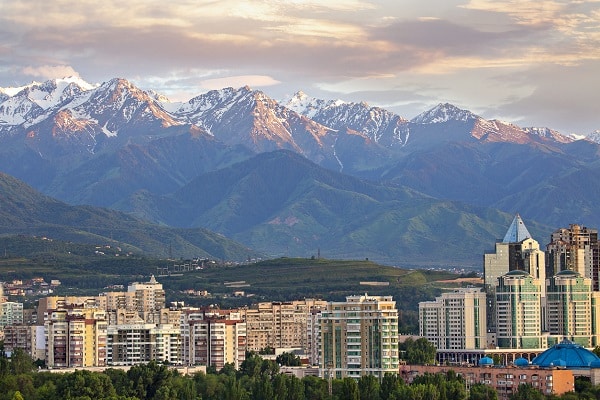By William Tucker, Edge Contributor
Earlier in the year, United States Secretary of State Antony Blinken paid a visit to the Central Asian states of Kazakhstan and Uzbekistan with an eye towards expanding relations, specifically in the areas of trade and military cooperation.
U.S. diplomatic outreach towards Central Asia would continue expeditiously over the next few months, culminating with U.S. President Joe Biden meeting with all five Central Asian heads of state at the recent UN General Assembly in New York.
Washington has been accused of ignoring Central Asia. Though, to be fair, it is a landlocked region directly bordered by Russia and China and it has been wracked with instability following the Soviet collapse. Yet, each of these five nations have stabilized to a degree over the past decade; and with Russia overextended in Ukraine and China’s economic issues, Central Asia is looking for new partners.
Washington can offer these nations quite a bit in the realm of security and economics, but any expectation that the U.S. can replace the long-time influence of Moscow is unrealistic. Instead, the U.S. can invest in the region with a mind toward pushing for a stable Central Asia that can hold its own against its much larger neighbors.
Central Asia’s Complicated Geographical History
The ensuing chaos following the fall of the Soviet Union may have brought independence to many nations in Europe and Asia, but while European nations had the advantage of proximity to a functional democratic West, the Caucasus and Central Asia were largely on their own.
Kazakhstan, Uzbekistan, Turkmenistan, Tajikistan, and Kyrgyzstan have all grappled with political instability, stemming from dysfunctional dictatorships or poorly run democracies that proved inept at exploiting their nations natural resources and improving economic conditions. This has improved to an extent once the Central Asian states managed to somewhat diversify away from Moscow, but they still have a fluid security environment owing to their proximity to powerful neighbors or dissatisfied ethnic groups.
Centuries of Conflict
The area we call Central Asia spans from the Tien Shan mountains bordering China in the south to the Eurasian Steppe in the north. The Caspian Sea forms the border to the west while the Altay mountains form the region to the east. This geography—unfortunately for Central Asia’s inhabitants—is highly susceptible to invasion owing to the vast and open Eurasian Steppe that straddles the current Kazakh border.
The Eurasian Steppe has historically served as an invasion superhighway of sorts for conquerors (Genghis Khan and Tamerlane among them) and has led to constantly shifting borders and fickle political alliances.
Stalin and the Soviet Union
These mercurial borders came to a halt once the nascent state of Russia expanded and consolidated its territory to the point that Moscow became a power broker in the region. From 1825 to 1914, Russia would slowly take control over the entirety of Central Asia and portions of China.
Eventually, the Russian Empire gave way to the Soviet Union and the Central Asian territories were reorganized by Joseph Stalin. His rationale for redrawing the borders of Central Asia stemmed from centuries of expansion that saw the Russian Empire swallow up numerous, non-Russian peoples.
It was under Stalin’s leadership that borders crossed the historic lands of numerous ethnicities thus separating people and preventing them from consolidating and challenging the security of the Soviet state. In places where the borders could not be changed, Stalin ordered the native inhabitants removed to other regions of Russia. Stalin’s decisions undertaken nearly a century ago still stand at the root of numerous conflicts today, including Central Asia’s frequent instabilities.
Beyond Stalin
The specter of Soviet decisions (and their impact on the modern world) do no rest with Stalin alone. When redrawing the Central Asian borders, Stalin divided the Ferghana valley, ensuring that the then-SSR’s would have to deal with one another over water rights from the major rivers in the region. Eventually, infrastructure and agricultural mismanagement by the Soviets would lead to the destruction of the Aral Sea and continuing desertification of Central Asia.
With water sources diminishing, Central Asia could easily see the return of political instability, but on a much higher scale.
Enter Washington
Central Asia has several major natural resources that could, if properly developed and managed, improve their respective economies. This could, perhaps, allow these nations to address the Soviet-initiated ecological problems.
Oil Exports
Kazakhstan and Turkmenistan have the lion’s share of oil and natural gas reserves in the region, and China is their primary export destination. However, with a slowing Chinese economy these two nations could see their profits diminish. The U.S., on the other hand, has expertise in energy extraction and pipeline construction, so there is an opportunity to export as a complement to sales to China.
Agriculture and Security
Other areas that could benefit from U.S. assistance: agriculture and security. Washington does have military experience working in the region thanks to its time in Afghanistan; and while it is unlikely to be a large presence, the availability of training and equipment that the U.S. can provide would be invaluable.
For the U.S., working with the Central Asian states would give Washington access to a region that it has historically found difficult to reach. And while the U.S. is unable to completely replace Russian influence, the U.S. can provide a roadmap that would allow the Central Asian states to operate independently and potentially withstand Russian interference.

Comments are closed.